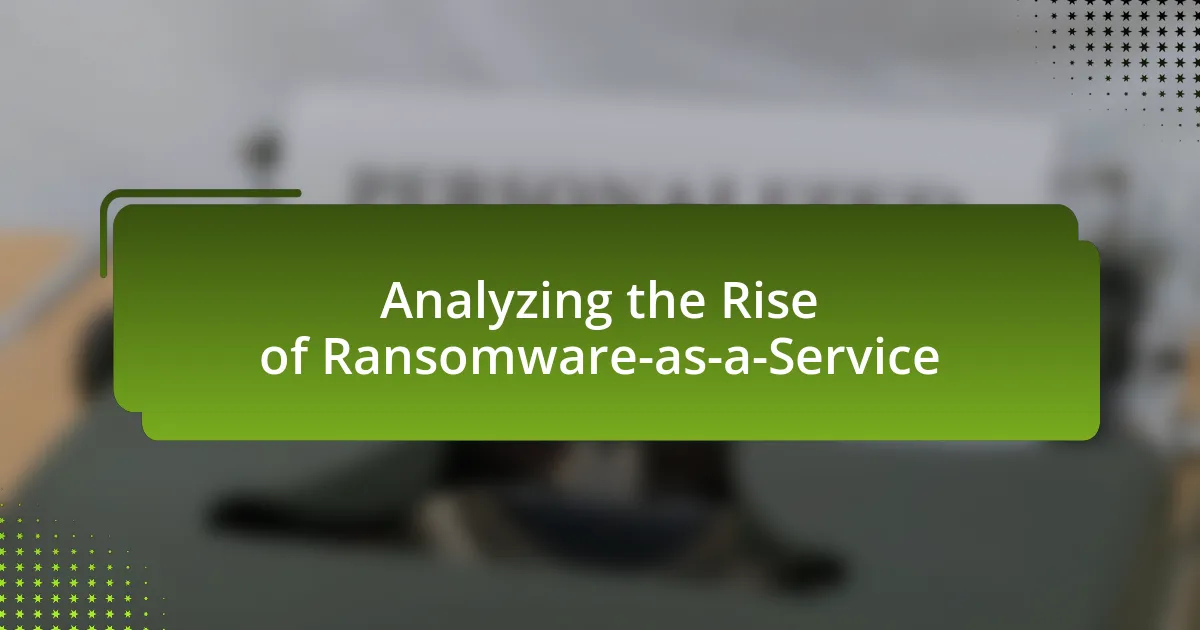Ransomware-as-a-Service (RaaS) is a business model that enables cybercriminals to offer ransomware tools and services to others, significantly lowering the technical barriers for launching attacks. This article analyzes the operational mechanisms of RaaS, its key components, and the factors contributing to its rising popularity, including the accessibility of sophisticated tools and the role of cryptocurrencies in facilitating transactions. It also discusses the implications for businesses, effective security measures, and the legal and ethical considerations surrounding RaaS. Emerging trends in the RaaS landscape, such as increased attack sophistication and the targeting of critical infrastructure, are examined, alongside best practices organizations can adopt to mitigate risks associated with these cyber threats.

What is Ransomware-as-a-Service?
Ransomware-as-a-Service (RaaS) is a business model where cybercriminals offer ransomware tools and services to other individuals or groups for a fee or a share of the ransom payments. This model allows less technically skilled criminals to launch ransomware attacks by providing them with ready-made software and support. The RaaS market has grown significantly, with reports indicating that it has contributed to a rise in ransomware incidents, as it lowers the barrier to entry for attackers. For example, in 2021, the FBI reported a 62% increase in ransomware incidents, highlighting the impact of RaaS on the overall threat landscape.
How does Ransomware-as-a-Service operate?
Ransomware-as-a-Service (RaaS) operates by providing a subscription-based model where cybercriminals can access ransomware tools and infrastructure without needing advanced technical skills. This model allows individuals or groups to launch ransomware attacks by paying a fee or sharing a percentage of the ransom collected with the service provider.
RaaS platforms typically offer user-friendly interfaces, tutorials, and customer support, making it accessible to a broader range of attackers. The service often includes features such as customizable ransomware variants, payment processing systems, and data exfiltration capabilities. According to a report by Cybersecurity Ventures, the RaaS market has significantly contributed to the increase in ransomware incidents, with estimated damages reaching billions of dollars annually.
What are the key components of Ransomware-as-a-Service?
The key components of Ransomware-as-a-Service (RaaS) include the ransomware software itself, a distribution network, payment processing systems, and customer support services. The ransomware software is the malicious code that encrypts victims’ data, while the distribution network facilitates the spread of the ransomware through various channels, such as phishing emails or exploit kits. Payment processing systems enable attackers to collect ransom payments, often in cryptocurrencies to maintain anonymity. Customer support services assist affiliates in deploying the ransomware and managing negotiations with victims, ensuring a streamlined operation. These components collectively create a profitable ecosystem for cybercriminals, evidenced by the increasing prevalence of RaaS platforms in cybercrime forums.
How do these components interact to facilitate attacks?
Ransomware-as-a-Service (RaaS) components interact through a collaborative ecosystem that enables attackers to execute sophisticated cyberattacks. RaaS platforms provide malware, infrastructure, and support services, allowing less technically skilled individuals to launch attacks. For instance, developers create and maintain ransomware code, while affiliates use this code to target victims, sharing profits with the developers. This symbiotic relationship reduces barriers to entry for cybercriminals, as evidenced by the increase in ransomware incidents, which rose by 150% in 2020 according to cybersecurity reports. The ease of access to these components accelerates the frequency and scale of ransomware attacks, demonstrating how their interaction facilitates widespread cybercrime.
Why has Ransomware-as-a-Service gained popularity?
Ransomware-as-a-Service has gained popularity due to its accessibility and the low technical barrier for entry it offers to cybercriminals. This model allows individuals with limited technical skills to launch sophisticated ransomware attacks by purchasing or renting ransomware tools from developers. According to a report by Cybersecurity Ventures, the global cost of ransomware damage is projected to reach $265 billion by 2031, highlighting the lucrative nature of these attacks. The proliferation of online forums and marketplaces has further facilitated the distribution of Ransomware-as-a-Service, making it easier for attackers to find resources and collaborate.
What factors contribute to the rise of Ransomware-as-a-Service?
The rise of Ransomware-as-a-Service is primarily driven by the accessibility of sophisticated tools for cybercriminals, enabling even those with limited technical skills to launch attacks. This trend is supported by the proliferation of online forums and marketplaces where ransomware kits are sold, often accompanied by customer support and tutorials. Additionally, the increasing profitability of ransomware attacks, evidenced by the average ransom payment reaching over $200,000 in 2021, incentivizes more individuals to enter the market. The anonymity provided by cryptocurrencies further facilitates transactions, making it easier for attackers to receive payments without detection.
How does the accessibility of Ransomware-as-a-Service impact cybercrime?
The accessibility of Ransomware-as-a-Service (RaaS) significantly increases the prevalence of cybercrime by lowering the technical barriers for potential attackers. This model allows individuals with limited technical skills to launch sophisticated ransomware attacks, thereby expanding the pool of cybercriminals. According to a report by Cybersecurity Ventures, the global cost of ransomware damage is projected to reach $265 billion by 2031, illustrating the financial impact of this trend. Furthermore, the ease of access to RaaS platforms facilitates rapid deployment of attacks, leading to a surge in incidents targeting businesses and individuals alike.

What are the implications of Ransomware-as-a-Service for businesses?
Ransomware-as-a-Service (RaaS) significantly increases the risk of cyberattacks for businesses by lowering the barrier to entry for cybercriminals. This model allows individuals with limited technical skills to launch sophisticated ransomware attacks, leading to a surge in incidents targeting organizations of all sizes. According to a report by Cybersecurity Ventures, ransomware damages are projected to reach $265 billion globally by 2031, highlighting the financial threat posed to businesses. Furthermore, RaaS can result in operational disruptions, reputational damage, and potential legal liabilities, as companies may struggle to recover data and maintain customer trust after an attack. The proliferation of RaaS underscores the necessity for enhanced cybersecurity measures and incident response strategies within organizations.
How can businesses protect themselves from Ransomware-as-a-Service attacks?
Businesses can protect themselves from Ransomware-as-a-Service attacks by implementing a multi-layered cybersecurity strategy that includes regular data backups, employee training, and robust security measures. Regularly backing up data ensures that businesses can restore their systems without paying a ransom, as studies show that 93% of companies that lose their data for more than 10 days file for bankruptcy within a year. Employee training on recognizing phishing attempts and suspicious activities reduces the likelihood of successful attacks, as human error is a significant factor in ransomware incidents. Additionally, employing advanced security solutions such as firewalls, intrusion detection systems, and endpoint protection can help detect and mitigate threats before they cause damage. According to the Cybersecurity and Infrastructure Security Agency, maintaining up-to-date software and applying security patches promptly is crucial in defending against vulnerabilities exploited by ransomware.
What security measures are most effective against Ransomware-as-a-Service?
Effective security measures against Ransomware-as-a-Service include regular data backups, robust endpoint protection, and employee training on phishing awareness. Regular data backups ensure that organizations can restore their systems without paying ransoms, as evidenced by a 2021 report from Cybersecurity Ventures indicating that 60% of companies that paid ransoms still did not regain access to their data. Robust endpoint protection, such as antivirus software and intrusion detection systems, can prevent ransomware from infiltrating networks, with studies showing that organizations using advanced threat detection saw a 50% reduction in successful attacks. Employee training on phishing awareness is crucial, as human error is a significant factor in ransomware attacks; a report by the Ponemon Institute found that 43% of data breaches involved human error.
How can employee training mitigate risks associated with Ransomware-as-a-Service?
Employee training can mitigate risks associated with Ransomware-as-a-Service by equipping staff with the knowledge to recognize and respond to potential threats. Training programs that focus on identifying phishing attempts, understanding safe browsing practices, and recognizing suspicious email attachments can significantly reduce the likelihood of employees inadvertently facilitating a ransomware attack. According to a report by the Ponemon Institute, organizations that implement regular security awareness training can reduce the risk of a successful cyber attack by up to 70%. This statistic underscores the effectiveness of training in enhancing employee vigilance and fostering a security-conscious culture within organizations.
What are the legal and ethical considerations surrounding Ransomware-as-a-Service?
Ransomware-as-a-Service (RaaS) raises significant legal and ethical considerations, primarily due to its facilitation of cybercrime. Legally, individuals and organizations involved in RaaS can face prosecution under various cybersecurity laws, such as the Computer Fraud and Abuse Act in the United States, which criminalizes unauthorized access to computer systems. Additionally, jurisdictions worldwide are increasingly implementing stringent regulations, such as the General Data Protection Regulation (GDPR) in Europe, which imposes heavy fines for data breaches resulting from ransomware attacks.
Ethically, RaaS poses dilemmas regarding accountability and responsibility. The model allows individuals with limited technical skills to launch attacks, blurring the lines of culpability. This raises questions about the moral implications of profiting from harm caused to victims, as well as the responsibilities of platform providers in preventing misuse of their services. The proliferation of RaaS also undermines trust in digital systems, as organizations must navigate the risks of potential attacks while balancing their operational needs.
How do laws vary regarding ransomware payments across different regions?
Laws regarding ransomware payments vary significantly across different regions, reflecting diverse legal frameworks and regulatory approaches. In the United States, for example, there is no federal law prohibiting ransomware payments, but the FBI advises against them, and certain states have enacted laws requiring businesses to report ransomware attacks. In contrast, countries like Germany have stricter regulations, where paying ransoms can lead to criminal liability under anti-money laundering laws. Additionally, the European Union is developing regulations that may impose obligations on organizations to report ransomware incidents and potentially restrict payments. These regional differences highlight the complexity of navigating legal landscapes in the context of ransomware incidents.
What ethical dilemmas do organizations face when dealing with Ransomware-as-a-Service?
Organizations face significant ethical dilemmas when dealing with Ransomware-as-a-Service, primarily revolving around the decision to pay ransoms or not. Paying ransoms can be seen as supporting criminal activity, potentially encouraging further attacks, while not paying may result in data loss and operational disruption. Additionally, organizations must consider the implications of data privacy and the potential harm to stakeholders if sensitive information is compromised. According to a 2021 report by Cybersecurity Ventures, ransomware attacks are projected to cost businesses over $20 billion annually by 2021, highlighting the financial pressures organizations face in these situations. This financial burden complicates ethical decision-making, as organizations weigh the immediate need to restore operations against the long-term consequences of their actions.

What trends are emerging in the Ransomware-as-a-Service landscape?
Emerging trends in the Ransomware-as-a-Service (RaaS) landscape include increased sophistication of attacks, the rise of affiliate programs, and the targeting of critical infrastructure. Sophisticated attacks often utilize advanced encryption methods and double extortion tactics, where attackers not only encrypt data but also threaten to leak sensitive information. The rise of affiliate programs allows cybercriminals to collaborate, enabling less skilled individuals to launch attacks by leveraging established RaaS platforms. Additionally, critical infrastructure sectors, such as healthcare and energy, are increasingly targeted due to their vulnerability and the potential for significant disruption, as evidenced by high-profile incidents like the Colonial Pipeline attack in 2021. These trends indicate a growing threat landscape that organizations must navigate.
How is technology evolving in the context of Ransomware-as-a-Service?
Technology is evolving in the context of Ransomware-as-a-Service (RaaS) through the increasing sophistication of attack tools and the accessibility of these services to less technically skilled criminals. RaaS platforms now offer user-friendly interfaces, allowing individuals with minimal technical knowledge to launch ransomware attacks. For instance, the emergence of subscription-based models enables users to pay for ransomware kits, which include customer support and updates, thereby lowering the barrier to entry for cybercriminals. Additionally, advancements in encryption techniques and obfuscation methods enhance the effectiveness of ransomware, making detection and decryption more challenging for victims and security professionals. According to a report by Cybersecurity Ventures, the global cost of ransomware is projected to reach $265 billion by 2031, highlighting the growing impact and evolution of RaaS technology.
What role do cryptocurrencies play in Ransomware-as-a-Service transactions?
Cryptocurrencies serve as the primary medium of exchange in Ransomware-as-a-Service (RaaS) transactions, facilitating anonymous payments to cybercriminals. This anonymity is crucial for ransomware operators, as it helps them evade law enforcement and maintain operational security. For instance, Bitcoin and other cryptocurrencies allow for pseudonymous transactions, making it difficult to trace the funds back to the perpetrators. According to a report by Chainalysis, in 2021, ransomware payments exceeded $600 million, with a significant portion transacted in cryptocurrencies, underscoring their central role in this illicit ecosystem.
How are law enforcement agencies adapting to combat Ransomware-as-a-Service?
Law enforcement agencies are adapting to combat Ransomware-as-a-Service by enhancing collaboration with international partners and investing in advanced cybersecurity training. These agencies recognize that ransomware attacks often cross borders, necessitating a coordinated response; for instance, the FBI collaborates with Europol and Interpol to share intelligence and resources. Additionally, agencies are focusing on developing specialized units that are trained in digital forensics and incident response, which is crucial given that the FBI reported a 300% increase in ransomware incidents in 2020 alone. By leveraging technology and fostering partnerships, law enforcement aims to disrupt ransomware operations and hold perpetrators accountable.
What best practices should organizations adopt to counter Ransomware-as-a-Service?
Organizations should adopt a multi-layered cybersecurity strategy to counter Ransomware-as-a-Service. This includes implementing regular data backups, which should be stored offline to prevent ransomware from encrypting them. Additionally, organizations must ensure that all software and systems are updated and patched promptly to close vulnerabilities that attackers exploit. Employee training on recognizing phishing attempts and suspicious links is crucial, as human error often facilitates ransomware attacks. Furthermore, deploying advanced threat detection tools, such as endpoint detection and response (EDR) solutions, can help identify and mitigate threats before they escalate. According to the Cybersecurity and Infrastructure Security Agency (CISA), organizations that adopt these practices significantly reduce their risk of falling victim to ransomware attacks.
How can incident response plans be optimized for Ransomware-as-a-Service threats?
Incident response plans can be optimized for Ransomware-as-a-Service threats by incorporating proactive threat intelligence, regular training simulations, and a clear communication strategy. Proactive threat intelligence allows organizations to stay informed about emerging ransomware variants and tactics used by attackers, enabling them to adjust their defenses accordingly. Regular training simulations ensure that incident response teams are well-prepared to handle ransomware incidents effectively, as studies show that organizations with frequent drills can reduce response times by up to 50%. A clear communication strategy is essential for coordinating responses across departments and with external stakeholders, which is critical given that 70% of ransomware attacks involve data exfiltration, necessitating timely notifications to affected parties.
What proactive measures can organizations implement to reduce vulnerability?
Organizations can implement several proactive measures to reduce vulnerability, including regular software updates, employee training, and robust security protocols. Regular software updates ensure that systems are protected against known vulnerabilities, as outdated software is a common entry point for cyberattacks. Employee training enhances awareness of phishing and social engineering tactics, which are frequently used in ransomware attacks. Additionally, implementing robust security protocols, such as multi-factor authentication and network segmentation, can significantly limit unauthorized access and contain potential breaches. According to a report by Cybersecurity Ventures, organizations that adopt these measures can reduce their risk of ransomware attacks by up to 70%.



